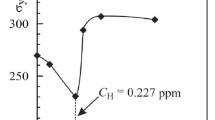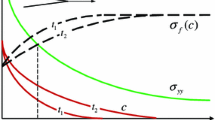We propose a computational model for the evaluation of the effect of hydrogen on the level of creep strains in the metal in the complex stressed state and determine the stress-strain state of a thin-walled tubular specimen under the conditions of complex loading and creep in the process of hydrogenation of the metal. The influence of the loading mode on the time to fracture of the specimen is established. It is shown that the specimens subjected to tension with internal pressure fail faster (by 30%) than the specimens tested by uniaxial tension and that hydrogen decreases the service life of the material by about 14% for all loading modes.




Similar content being viewed by others
References
H. Moustabchir, Z. Azari, S. Hariri, and I. Dmytrakh, “Experimental and computed stress distribution ahead of a notch in a pressure vessel: application of T-stress conception,” Comput. Mater. Sci., 58, 59–66 (2012).
А. М. Syrotyuk and I. M. Dmytrakh, “Methods for the evaluation of fracture and strength of pipeline steels and structures under the action of working media. Part 2. Influence of hydrogen-containing media,” Fiz.-Khim. Mekh. Mater., 50, No. 4, 7–17 (2014); English translation: Mater. Sci., 50, No. 4, 475–487 (2015).
A. M. Lokoshchenko, “Long-term strength of metals in complex stress state (a survey),” Izv. Akad. Nauk. Mekh. Tverd. Tela, No. 3, 116–136 (2012); English translation: Mech. Solids, 47, No. 3, 357–372 (2012).
A. M. Lokoshchenko and S. A. Shesterikov, “Methods for the description of creep and long-term strength in pure tension,” Prikl. Mekh. Tekh. Fiz., No. 3, 155–159 (1980).
A. M. Lokoshchenko and L. V. Fomin, “Delayed fracture of plates under creep condition in unsteady complex stress state in the presence of aggressive medium,” Appl. Math. Model., 60, 478–489 (2018).
O. K. Morachkovskii and Yu. V. Romashov, “Continual model of propagation of corrosion cracks for the evaluation of the service life of structures,” Fiz.-Khim. Mekh. Mater., 46, No. 2, 111–116 (2010); English translation: Mater. Sci., 46, No. 2, 254–259 (2010).
S. Murakami, Y. Liu, and M. Mizuno, “Computational methods for creep fracture analysis by damage mechanics,” Comput. Methods Appl. Mech. Eng., 183, No. 1-2, 15–33 (2000).
M. Stashchuk and M. Dorosh, “Analytical evaluation of hydrogen induced stress in metal,” Int. J. Hydrog. Energy, 42, No. 9, 6394–6400 (2017).
O. V. Hembara and O. E. Andreikiv, “Effect of hydrogenation of the walls of oil-and-gas pipelines on their soil corrosion and service life,” Fiz.-Khim. Mekh. Mater., 47, No. 5, 27–34 (2011); English translation: Mater. Sci., 47, No. 5, 598–607 (2012).
V. Panasyuk, Y. Ivanytskyi, and O. Hembara, “Assessment of hydrogen effect on fracture resistance under complex-mode loading,” Eng. Fract. Mech., 83, 54–61 (2012).
O. V. Hembara, Z. O. Terlets’ka, and O. Ya. Chepil’, “Determination of electric fields in electrolyte-metal systems,” Fiz.-Khim. Mekh. Mater., 43, No. 2, 71–77 (2007); English translation: Mater. Sci., 43, No. 2, 222–229 (2007).
Yu. N. Rabotnov, Creep of Structural Elements [in Russian], Nauka, Moscow (1966).
Q. Jiang, О. V. Hembara, and О. Y. Chepil', “Modeling of the influence of hydrogen on the accumulation of defects in steels under high-temperature creep,” Fiz.-Khim. Mekh. Mater., 55, No. 2, 104–111 (2019); English translation: Mater. Sci., 55, No. 2, 245–253 (2019).
F. Qin, O. V. Hembara, and O. Ya. Chepil’, “Modeling of the influence of hydrogen on the bearing ability of elements of the powergenerating equipment under the conditions of temperature creep,” Fiz.-Khim. Mekh. Mater., 53, No. 4, 99–106 (2017); English translation: Mater. Sci., 53, No. 4, 532–540 (2018).
Ch. Shu, O. V. Hembara, and O. Ya. Chepil’, “Calculation of the lifetime of heat and power equipment under long-term static loading, high temperature, and the action of hydrogen,” Fiz.-Khim. Mekh. Mater., 54, No. 1, 105–111 (2018); English translation: Mater. Sci., 54, No. 1, 107–114 (2018).
O. V. Hembara, O. Ya. Chepil,’ and T. V. Hembara, “Application of the energy approach to the evaluation of the serviceability of the drum of a steam boiler subjected to thermal cycling and hydrogenation,” Fiz.-Khim. Mekh. Mater., 53, No. 1, 90–95 (2017); English translation: Mater. Sci., 53, No. 1, 102–108 (2017).
O. V. Hembara, O. Ya. Chepil’, and N. T. Hembara, “Influence of the parameters of discretization on the accuracy of numerical solution of the three-dimensional problem of hydrogen diffusion,” Fiz.-Khim. Mekh. Mater., 52, No. 2, 119–123 (2016); English translation: Mater. Sci., 52, No. 2, 280–286 (2016).
Ya. L. Ivanyts’kyi, O. V. Hembara, and O. Ya. Chepil’, “Determination of the durability of elements of power-generating equipment with regard for the influence of working media,” Fiz.-Khim. Mekh. Mater., 51, No. 1, 93–101 (2015); English translation: Mater. Sci., 51, No. 1, 104–113 (2015).
Ya. Ivanytskyi, Ye. Kharchenko, O. Hembara, O. Chepil, Ya. Sapuzhak, and N. Hembara, “The energy approach to the evaluation of hydrogen effect on the damage accumulation,” Proced. Struct. Integr., 16, 126–133 (2019).
L. M. Kachanov, Theory of Creep [in Russian], Fizmatlit, Moscow (1960).
O. Andreikiv and O. Hembara, Fracture Mechanics and Durability of Metallic Materials in Hydrogen-Containing Media [in Ukrainian], Naukova Dumka, Kyiv (2008).
V. P. Radchenko, E. V. Nebogina, and E. A. Andreeva, “Structural model of a material softening under the conditions of complex stress state,” Vest. Samarsk. Gos. Tekh. Univ., Ser. Fiz.-Mat. Nauki, No. 1 (18), 75–84 (2009).
Acknowledgements
The present work was financially supported by the National Research Foundation of Ukraine (Project No. 2020.02/0049), Technology Innovation Special Program of Hubei Province (2019AAA047) and the Key Technologies R&D Program of Hubei Province (2020BHB004).
Author information
Authors and Affiliations
Corresponding author
Additional information
Translated from Fizyko-Khimichna Mekhanika Materialiv, Vol. 57, No. 3, pp. 103–109, May–June, 2021.
Rights and permissions
About this article
Cite this article
Jin, C., Hembara, О.V. & Hrynenko, M.V. Computer Modeling of the Deformation of Structural Elements Under the Conditions of Creep in the Course of Hydrogenation of the Metal Under Complex Loading. Mater Sci 57, 397–403 (2021). https://doi.org/10.1007/s11003-022-00561-6
Received:
Published:
Issue Date:
DOI: https://doi.org/10.1007/s11003-022-00561-6




